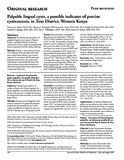Palpable lingual cysts, a possible indicator of porcine cysticercosis, in Teso District, Western Kenya

View/
Date
2006Author
Njeruh, Francis M
Willingham, Arve L
Githigia, Samuel M
Kitala, Philiph M
Arimi, Samuel M
Randolph, Thomas F
Mutua, Florence K
Type
ArticleLanguage
enMetadata
Show full item recordAbstract
To estimate the prevalence of
palpable lingual cysts in pigs in Western
Kenya, a possible indicator of porcine
cysticercosis, and to study the potential risk
factors associated with this clinical finding.
During a cross-sectional survey,
316 randomly selected small-scale farms
were visited, from which a case-control
study of 31 case farms and 93 randomly
selected control farms was constructed.
Information on potential risk factors for
Taenia solium cysticercosis-taeniosis was
obtained using questionnaires administered
via personal interviews.
Farm prevalence of palpable
lingual cysts was estimated at 9.8% (31
of 316) (95% confidence interval [CI],
6.5%-13.1%). Total number of pigs testing
positive was 33, resulting in a pig prevalence
of 6.5% (95% CI, 4%-9%). Pigs
were kept as a source of income (98%) and
for home consumption (2%). Sources of
pigs included local purchases (94%; 117
of 124), and purchases from Uganda (6%;
seven of 124). Most farmers (95%; 118 of
124) kept their pigs on free range. Pork was
sourced from local butcheries (85%) and
home slaughtering (15%). Most households
slaughtering pigs at home had their
pork “inspected” by household friends (five
of nine). Absence of latrines was more common
in case households (42%; 13 of 31)
than in controls (18%; 17 of 93) (P = .01;
OR = 3.2; 95% CI, 1.2%-
8.55).
Palpable lingual cysts are
prevalent in the locally raised pigs of
Western Kenya. Further studies using more
sensitive diagnostic tests are required to
confirm the risk of porcine cysticercosis.
Publisher
Faculty of Agriculture
Collections
- Faculty of Agriculture [226]
